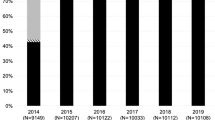Abstract
We assessed the effects of beliefs about state HIV criminal law on condomless anal sex (CAS < 3 months) among men who have sex with men (MSM) residing in 16 US states (n = 2013; M = 36 years old; 75 % White; 82 % HIV-negative) completing an online survey in 2010 and stratified by residency in a state with any or sex-specific HIV criminal law(s) or where a HIV-related arrest, prosecution, or sentence enhancement (APSE) had occurred. Three-quarters of MSM reported that they were unsure of the law in their state. Men who believed there was a HIV law in their state but lived in states without any or a sex-specific HIV criminal law(s) had higher probabilities of CAS compared to those who were unsure of their state’s law; men who believed there was a HIV law in their state and lived in a state where an APSE had occurred had higher probabilities of CAS compared to those who were unsure of their state’s law. Correct knowledge of state law was not associated with CAS. Findings suggest that HIV criminal laws have little or counter-productive effects on MSM’s risk behavior.
Similar content being viewed by others
References
Lehman JS, Carr M, Nichol A, Ruisanchez A, Knight D, Langford A, et al. Prevalence and public health implications of state laws that criminalize potential HIV exposure in the United States. AIDS Behav. 2014;18(6):997–1006.
The Center for HIV Law & Policy. HIV criminalization: state laws criminalizing conduct based on HIV status (cited 2012 May 8). 2012. http://www.hivlawandpolicy.org/resources/view/198. Accessed 8 May 2012.
Cohen MS, Chen YQ, McCauley M, Gamble T, Hosseinipour MC, Kumarasamy N, et al. Prevention of HIV-1 infection with early antiretroviral therapy. N Engl J Med. 2011;365:493–505.
Centers for Disease Control and Prevention HRaSA, National Institutes of Health, American Academy of HIV Medicine, Association of Nurses in AIDS Care, International Association of Providers of AIDS Care, the National Minority AIDS Council, and Urban Coalition for HIV/AIDS Prevention Services,. Recommendations for HIV Prevention with Adults and Adolescents with HIV in the United States. 2014. http://stacks.cdc.gov/view/cdc/26062. Accessed 11 Dec 2014.
Centers for Disease Control and Prevention. HIV among gay, bisexual and other men who have sex with men (MSM). (updated March 21, 2013; cited 2013 April 16). 2013. http://www.cdc.gov/hiv/topics/msm/.
Galletly CL, Glasman LR, Pinkerton SD, Difranceisco W. New Jersey’s HIV exposure law and the HIV-related attitudes, beliefs, and sexual and seropositive status disclosure behaviors of persons living with HIV. Am J Public Health. 2012;102(11):2135–40.
The White House Office of National AIDS Policy. National HIV/AIDS strategy for the United States. 2010. http://www.whitehouse.gov/administration/eop/onap/nhas.
Galletly CL, Pinkerton SD, DiFranceisco W. A quantitative study of Michigan’s criminal HIV exposure law. AIDS Care. 2012;24(2):174–9.
Horvath KJ, Weinmeyer R, Rosser S. Should it be illegal for HIV-positive persons to have unprotected sex without disclosure? An examination of attitudes among US men who have sex with men and the impact of state law. AIDS Care. 2010;22(10):1221–8.
Burris S, Beletsky L, Burleson J, Case P, Lazzarini Z. Do criminal laws influence HIV risk behavior? An empirical trial. Ariz State Law J. 2007;39:467–519.
Galletly C, Lazzarini Z, Sanders C, Pinkerton SD. Criminal HIV exposure laws: moving forward. AIDS Behav. 2014;18(6):1011–3.
Centers for Disease Control and Prevention. HIV Surveillance Report, 2013; vol. 25. (Published February 2015) [cited 2015 September 21]. 2013. http://www.cdc.gov/hiv/library/reports/surveillance/.
The Center for HIV Law & Policy. State-by-State Criminal Laws Used to Prosecute People with HIV. 2012. http://www.hivlawandpolicy.org/resources/view/763. Accessed 16 April 2013.
Bennett-Carlson R, Faria D, Hanssens C. Ending and defending against HIV criminalization: state and federal laws and prosecutions. The Center for HIV Law and Policy. 2010. http://hivlawandpolicy.org/resources/ending-and-defending-against-hiv-criminalization-state-and-federal-laws-and-prosecutions. Positive Justice Project.
StataCorp. Stata Statistical Software. 12.1 ed. College Station: StataCorp LP; 2011.
Muller CJ, MacLehose RF. Estimating predicted probabilities from logistic regression: different methods correspond to different target populations. Int J Epidemiol. 2014;43(3):962–70.
Skinta MD, Murphy JL, Paul JP, Schwarcz SK, Dilley JW. Thoughts, attitudes, and feelings of HIV-positive MSM associated with high transmission-risk sex. Health Educ Behav. 2012;39(3):315–23.
Irvin R, Vallabhaneni S, Scott H, Williams JK, Wilton L, Li X, et al. Examining levels of risk behaviors among black men who have sex with Men (MSM) and the association with HIV acquisition. PLoS One. 2015;10(2):e0118281.
Shriver MD, Everett C, Morin SF. Structural interventions to encourage primary HIV prevention among people living with HIV. AIDS. 2000;14:S57–62.
Galletly CL, Pinkerton SD. Conflicting messages: how criminal HIV disclosure laws undermine public health efforts to control the spread of HIV. AIDS Behav. 2006;10(5):451–61.
Downing MJ. Perceived likelihood of HIV and sexually transmitted infection acquisition among men who have sex with men. J Assoc Nurses AIDS Care. 2014;. doi:10.1016/j.jana.2013.02.002.
Glanz K, Rimer BK, Lewis FM. Health belief model. Health behavior and health education. San Francisco: Jossey-Bass; 2002. p. 45–66.
Rosenstock I, Strecher V, Becker M. The health belief model and HIV risk behavior change. In: DiClemente R, Peterson J, editors. Preventing AIDS. AIDS prevention and mental health. New York: Springer; 1994. p. 5–24.
Lazzarini Z, Galletly CL, Mykhalovskiy E, Harsono D, O’Keefe E, Singer M, et al. Criminalization of HIV transmission and exposure: research and policy agenda. Am J Public Health. 2013;103(8):1350–3.
Acknowledgments
This study was undertaken as part of the ‘‘Structural Interventions to Lower Alcohol-related STI/HIV,’’ grant number R01AA01627001, funded by the US National Institute on Alcohol Abuse and Alcoholism (NIAAA).
Author information
Authors and Affiliations
Corresponding author
Rights and permissions
About this article
Cite this article
Horvath, K.J., Meyer, C. & Rosser, B.R.S. Men Who have Sex with Men Who Believe that Their State has a HIV Criminal Law Report Higher Condomless Anal Sex than Those Who are Unsure of the Law in Their State. AIDS Behav 21, 51–58 (2017). https://doi.org/10.1007/s10461-016-1286-0
Published:
Issue Date:
DOI: https://doi.org/10.1007/s10461-016-1286-0



